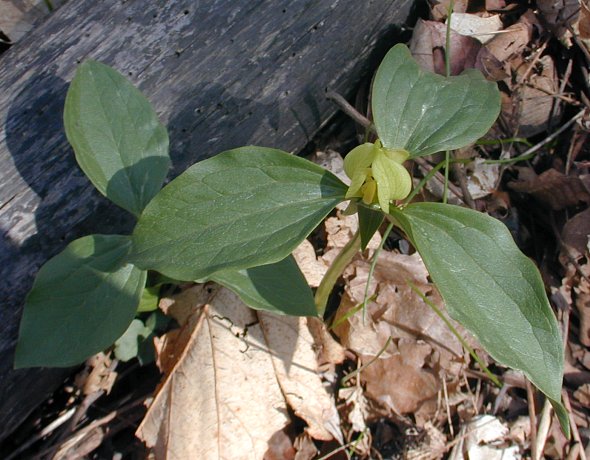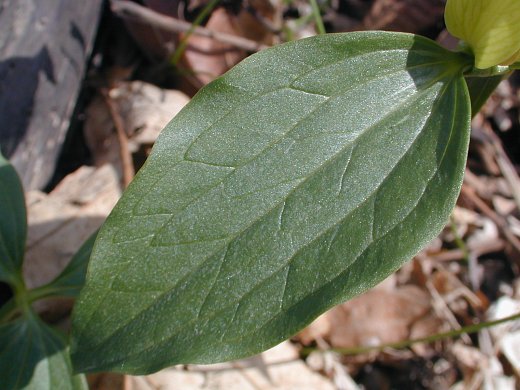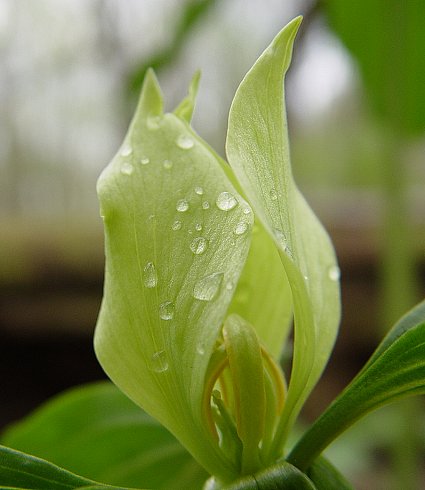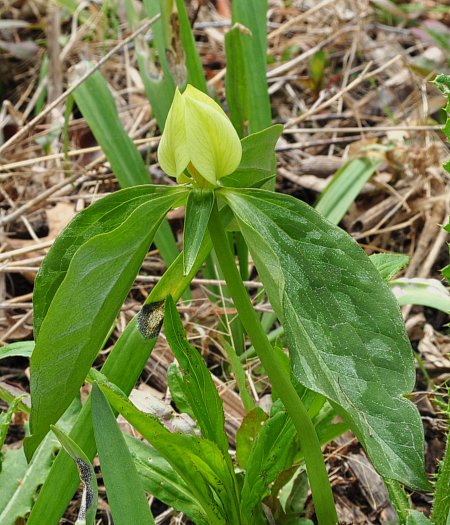Description: This herbaceous perennial plant is about ½–1¼' tall. It consists of a single erect stem that has 3 spreading leaves at its apex. A mature plant produces a single sessile flower above the leaves, while an immature plant produces only leaves. The stem is light green, medium green, or yellowish green; it is terete, glabrous, and fairly stout. The leaves are up to 6" long and 3½" across; they are ovate in shape and smooth along their margins, tapering into distinct petioles. The upper leaf surface is mottled with patches of light and dark green, although sometimes it is solid green. The lower leaf surface is pale green. Both surfaces are glabrous. In addition to parallel primary veins, the leaves also have diagonal secondary veins that crisscross between the primary veins. Each flower consists of 3 yellow petals, 3 green sepals, 6 yellow stamens, and a green ovary with 3 stigmata.

The petals are 1–1¼" long, rhombic-elliptic in shape, and erect, curving inward toward their tips. The sepals are ¾-1" long, glabrous, and triangular-lanceolate in shape; they hang downward from the base of the flower. The stamens are about ½" long, curving inward toward their tips; the large anthers of the stamens are narrowly oblongoid in shape and longer than the filaments. The blooming period occurs from mid- to late spring, lasting about 3-4 weeks. There is no noticeable floral scent. Individual flowers are fairly long-lasting. Afterwards, the flowers are replaced by 3-celled fruits (technically berries) that contain many small seeds. These fruits are a little less than ½" in length (about 10 mm.), rhombic-ovoid in shape, 6-angled, and greenish. The seeds are dark brown and partially white from their food appendages. The root system consists of a thickened erect rootstock, secondary fibrous roots, and rhizomes, from which clonal offsets are occasionally produced.

Cultivation:
This plant prefers dappled sunlight to medium shade, mesic levels
of moisture, and rich loamy soil with decaying leaf litter. Like other Trillium
spp.
(Trilliums), this species is slow to develop because of the short
period of active growth during the spring. The foliage persists until
about the middle of summer.
Range & Habitat:
The native Shay's Trillium is quite rare in Illinois. According to
official records, it has been observed in only Jackson County. However,
the webmaster encountered it in Champaign County a few years ago, and
there has been scattered sitings of Shay's Trillium in northern
Illinois (see Distribution
Map). Habitats include mesic deciduous woodlands where the
original flora has remained little disturbed by modern development.

Faunal
Associations:
The pollinators of the yellow flowers are unknown.
Caterpillars of the polyphagous moths Clepsis melaleucana
(Black-patched Clepsis) and Euplexia benesimilis
(American Angle Shades) feed on trilliums (Covell, 1984/2005). Because
of their food appendages, the seeds are distributed to new locations by
ants. White-tailed Deer are very fond of the foliage and flowers
of trilliums as a source of food. Their seeds can pass through the
digestive tract of these animals and germinate in new locations
(Vellend et al., 2003). However, too many deer can cause populations of
trilliums to decline because of excessive browsing.
Photographic Location:
A mesic deciduous woodland at Busey Woods in Urbana, Illinois, and a
woodlands in Ogle County, Illinois. The photograph of the Shay's
Trillium with mottled leaves was taken by Lisa Culp (Copyright © 2013).

Comments: Shay's Trillium (Trillium recurvatum shayii) is a rare form of the common Prairie Trillium (Trillium recurvatum). The typical form of this species has maroon flowers and black anthers. Another uncommon form of the Prairie Trillium that occurs within the state, Trillium recurvatum lutescens, has yellow flowers like Shay's Trillium, however its anthers are black or purple. In contrast, Shay's Trillium has yellow anthers. All three forms of this trillium usually have leaves that are mottled in different shades of green, however, plants with solid green leaves also occur. Regardless of its form, the Prairie Trillium differs from other trilliums in Illinois by the following set of characteristics: 1) its flowers are sessile, 2) its leaves have petioles, 3) its sepals hang downward, and 4) its petals are yellow or maroon. Other trilliums have flowers on short stalks, or their leaves are sessile, or their sepals are spreading to ascending, or their petals are white.